The Samsung Galaxy Note5 and Galaxy S6 edge+ Review
by Joshua Ho on October 2, 2015 8:00 AM ESTDisplay
With the rise of smartphones and tablets, the display has become one of the most important aspects of a mobile device as it’s the primary mode of interaction. However, throughout computing the display has generally had relatively little attention. People might have talked about resolution, size, and latency, but the discourse was vague at best. In order to really understand displays, it’s important to discuss a number of factors that affect display quality and the underlying design of the display. These factors range from subpixel arrangement to TFT structure and various emitter materials. With traditional reviewing methods, it’s often difficult to say one way or another whether one display is “better” than another. While simple metrics like maximum brightness can be compared in a relative manner, it’s hard to say whether one has better colors or higher static contrast. In order to test these metrics, we turn to objective measurements from devices like X-Rite’s i1Pro2 spectrophotometer and i1Display Pro colorimeter. In order to acquire the data from these devices and present it in a usable manner, we use SpectraCal’s CalMAN 5 with a custom workflow.
Under the microscope and based upon some quick viewing angle tests, subjectively the Galaxy Note5 display looks and feels like a bigger version of the Galaxy S6 display. Viewing angles for some angles feels like the display is almost painted on to the glass below, but some odd interference effects with viewing angle changes breaks the illusion to some extent. In the case of the S6 edge+, the curved edges of the display cause a noticeable shift in luminance when looking at the edge compared to the center of the display, which also causes an odd green shift which is probably due to the RGBG subpixel layout. I suspect the best LCDs will still be better at the “painted to the glass” illusion for the near future. This isn’t a huge deal, but it is a noticeable difference.
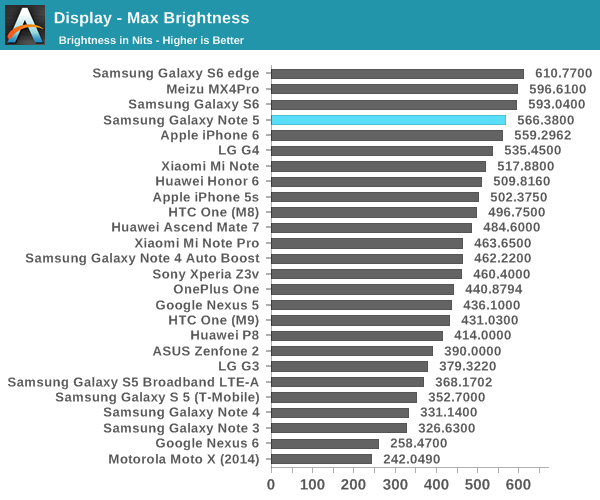
Moving on to our brightness testing, we can see that the Galaxy Note5 delivers a healthy improvement over the Galaxy Note 4 generation of AMOLED, but it isn’t quite at the same level as the Galaxy S6. It isn’t clear why this is the case, but I suspect this is related to longevity and other concerns outside of brightness. Meanwhile the use of OLED means that black levels are perfect and contrast remains solely determined by the lighting of the room and the reflectance of the display, which is similar to most other smartphones.
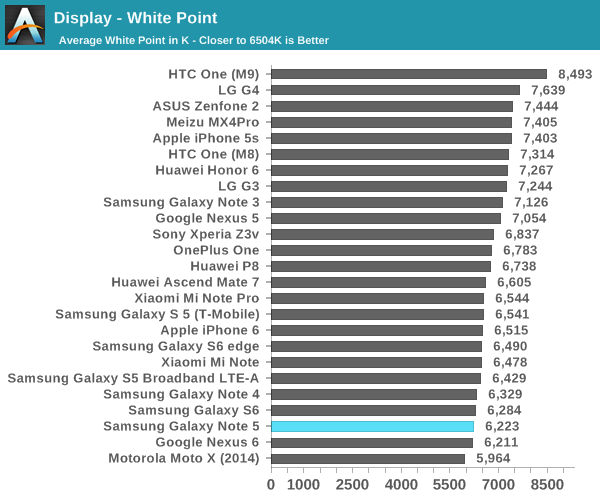
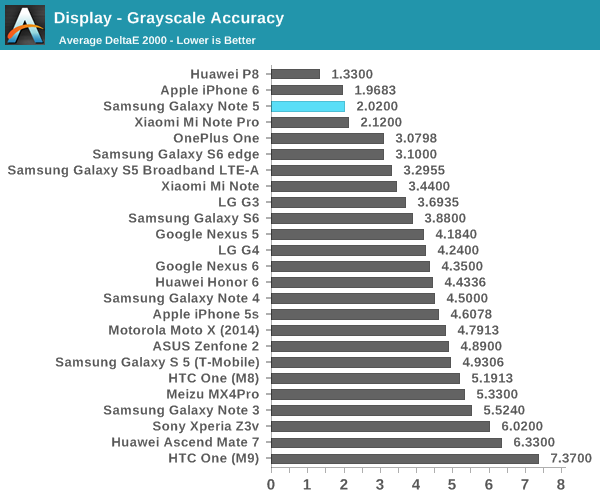
In our standard grayscale testing, the Note5 delivers acceptable color accuracy but it seems that the Basic screen mode tends towards a warm color balance. I suspect this helps with power efficiency, as blue in general requires more power to achieve the same level of luminance. Other than this slightly warm white balance, the grayscale accuracy doesn’t have any significant errors. This means accuracy ends up very good - certainly below our threshold for noticable errors - especially in comparison to the Galaxy Note 4 which had some noticeable problems with green tint on some units.
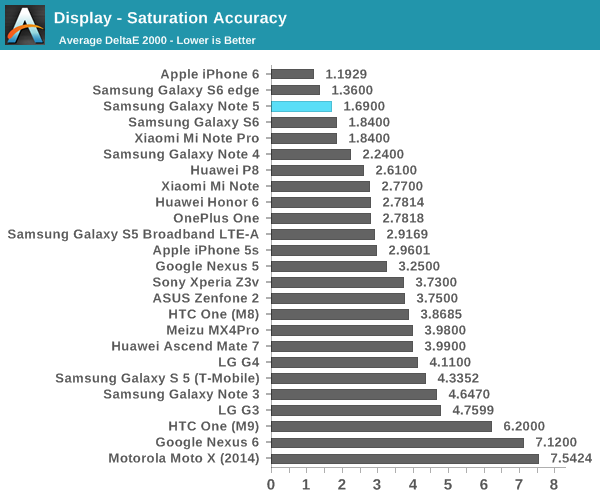
In our saturation test, Samsung does well enough that there’s really nothing to talk about because there's so little wrong here. You could argue that magenta is a bit warm on our review unit, but the difference is too small to be worth talking about. Error on average is going to be hard to spot unless you have a flawless reference monitor to compare against.
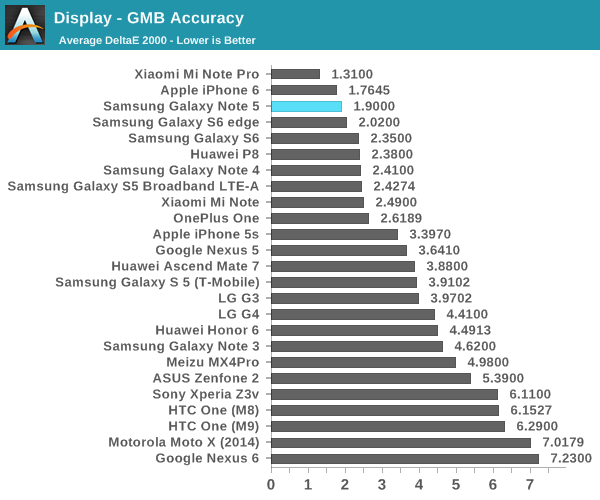
In the GMB ColorChecker test, Samsung continues to show a strong performance when looking at various hues that are commonly found in consumer content such as movies and camera photos. There’s a slight red shift on some of the tested hues, but the error is so minor I don’t notice that any problems here.
Overall, the Galaxy Note5 and Galaxy S6 edge+ both have an incredible display. The Galaxy S6 edge+ does have some problems with viewing angle shifts by virtue of the curved display, but this is effectively unavoidable given the subpixel layout and the radius of curvature. With this generation of AMOLED, Samsung has definitely equaled the best LCDs on the market. I suspect within the next year or two it will be inevitable that Samsung AMOLED will be clearly superior to even the best LCDs. However, without other OLED suppliers that can provide similar quality and cost I suspect OEM adoption will continue to be limited.



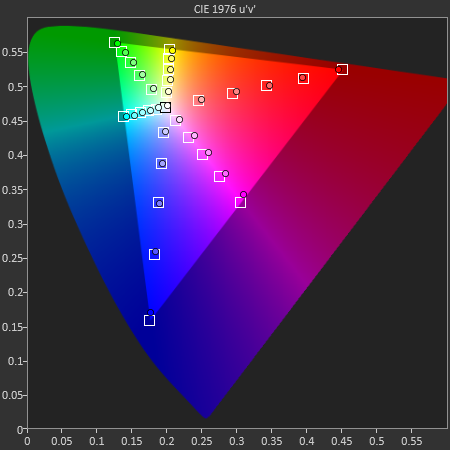
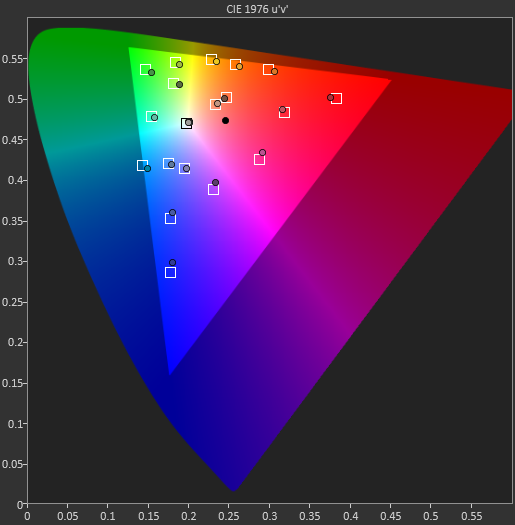








225 Comments
View All Comments
lopri - Friday, October 2, 2015 - link
Also odd that the author thinks the color shift on the Edge+ is due to RGBG subpixel layout. I thought the color shift would be there due to curves regardless of subpixel layout.In any case I give the author props for this effort. A rather thorough review, even if a little heavy on editorials.
lilmoe - Friday, October 2, 2015 - link
After being called out so many times, your "comparison charts" are still an absolute (intentional?) mess. Why do you have 25 different phones on one chart, and 10 completely different ones on others? Why is the crappiest browser on Android still being used for battery tests? Why is the iPhone 6 in GPU tests and the 6plus absent?While they do have really nice articles, Anandtech scores the lowest in the consistency department out of all sites. Please try being more consistent.
Can you just put 4-5 most popular phones of each platform on the SAME darn charts and keep them that way, without conveniently leaving some out and putting them back here and there? Like PLEASE?
Also, it would be nice if you'd explain why you're posting NAND performance benchmarks with your particular set of settings. I seriously find it VERY hard to believe that UFS 2.0 is equal or often slower than the very best of eMMC in sequentials and randoms.
lopri - Friday, October 2, 2015 - link
The real mess is the camera samples. (which by the way is not limited to Android devices for a change) It is maddening to sift through camera samples without knowing ahead what I am going to see only to click dozen more times to find out what I am looking for.Kuzi - Saturday, October 3, 2015 - link
Agreed their charts are a mess.Bob Todd - Friday, October 2, 2015 - link
The gigantor phone market is more competitive than ever, so it's interesting to see them dropping features and generally not taking full advantage of being the most vertically integrated Android OEM. They dropped microSD but capacity maxes out at 64GB. They had the opportunity to be ballsy and go higher capacity PCIe NVMe and absolutely crush every other Android OEM in storage performance. You have to *really* want the pen, because this looks like a tough sell at $780 for 64GB when $650 gets you a 128GB Nexus 6P and $500 gets you a 64GB Moto X Pure with expandable storage. Sure Samsung's SOC is better, but this is a pretty underwhelming release for me.TheinsanegamerN - Friday, October 2, 2015 - link
Not to mention the sealed, non removable battery. And samsung's terrible track record with updates.thedons1983 - Sunday, October 18, 2015 - link
Sealed, non removable battery = better looking device. Simple as. Never mind the fact, that most users do not want to swap the battery, as they simply don't need to. How obsessed with your phone are you anyway? You should probably try getting a life instead!!lilmoe - Friday, October 2, 2015 - link
Samsung knows a thing or two about fast storage, and their UFS 2.0 is pretty darn GOOD. It's just not showing well on you-know-who's charts.Bob Todd - Friday, October 2, 2015 - link
You are missing the point. They are charging more than "good enough" money for this thing. They need to offer compelling reasons to spend way more on this than the other solid new entries in this segment. Something like a PCIe NVMe solution would have been a good way to justify that price gap. I predict steep discounts (~$100+) shortly after launch.lilmoe - Friday, October 2, 2015 - link
"I predict steep discounts (~$100+) shortly after launch"They already priced the Note 5 cheaper than the Note 4 at launch. Sorry if American carriers are over charging.
"You are missing the point"
Read my *short* comment again. Their storage solution isn't particularly inferior. Random reads and writes are comparable, if not better. If you honestly believe that sequential performance is more important than random for everyday workloads, then I have nothing else to tell you. It's not like we have an extensive comparison of performance and power consumption/efficiency between Samsung's UFS 2.0 vs Apple's sourced NVMe solution (might not even be possible at this stage), nor is it the case that Samsung has already developed a miniature PCIe V-NAND 950 PRO NVMe SSD and is holding back to "cut corners".
Everything in this segment is overpriced, for better or worse. We just learn to "deal with it". That said, your point boils down to overall manufacturer costs, ie: BoM. You shouldn't make assumptions on your own over bits and pieces of the package. Samsung, despite manufacturing most of their parts, have a costlier BoM than most other OEMs, including Apple. Their external enclosure, AMOLED screens, Wacom Digitizers, DACs, etc. are always best in class and cost more than comparable parts from the competition. Other than the omission of SD-card controller, they went all out in every other detail (removable batteries don't contribute to cost, it's a design choice rather).
That said, I'd rather have them start with 64GB of standard storage (128GB option) and an SD-Card slot for a much more value proposition at that price range. A larger ~4000mah battery would have also been possible since the Note 5 is relatively large but is one of the lightest "phablet" out there. This goes for all manufacturers, not only Samsung.